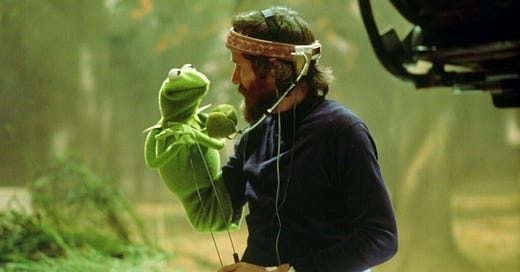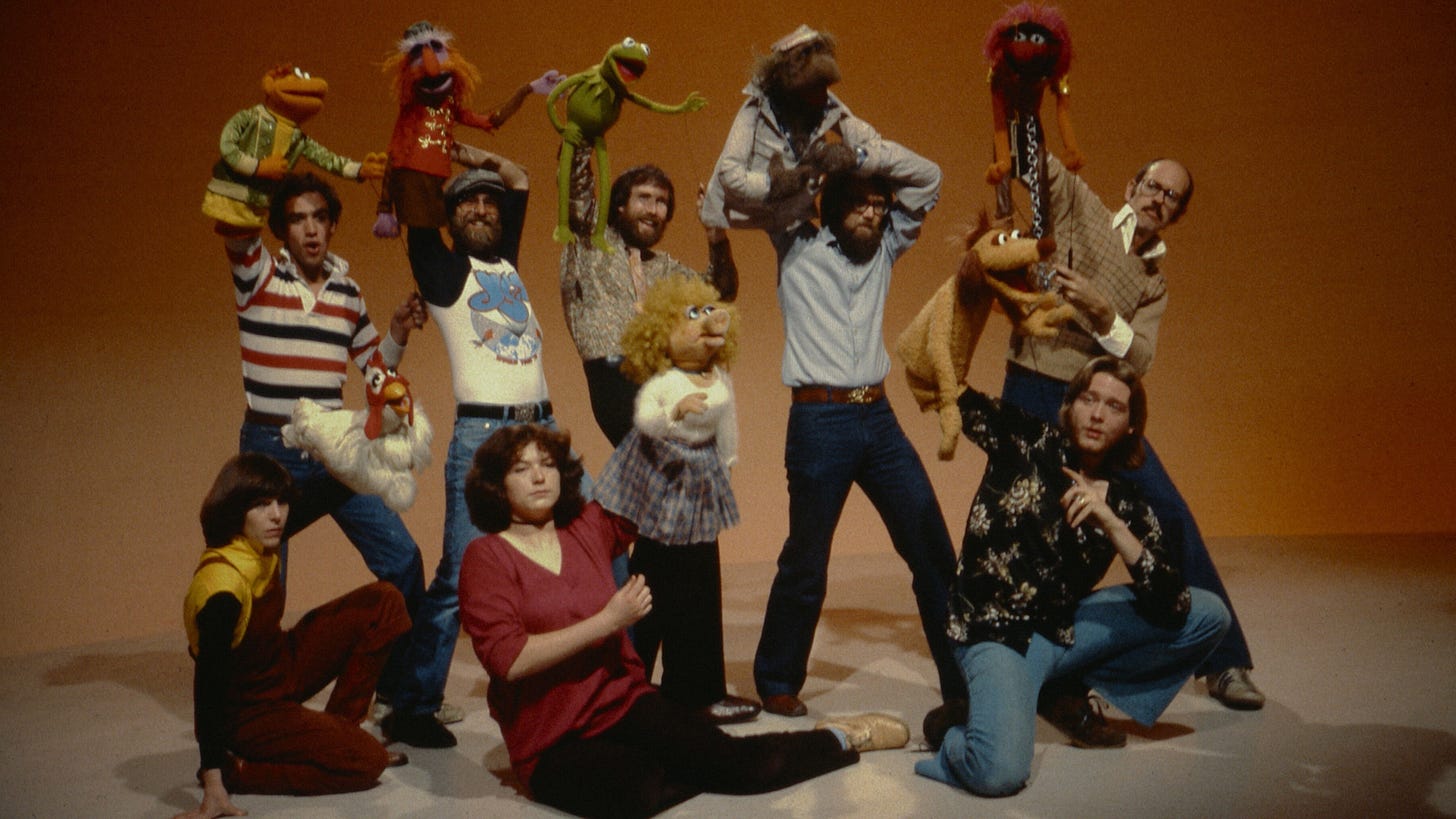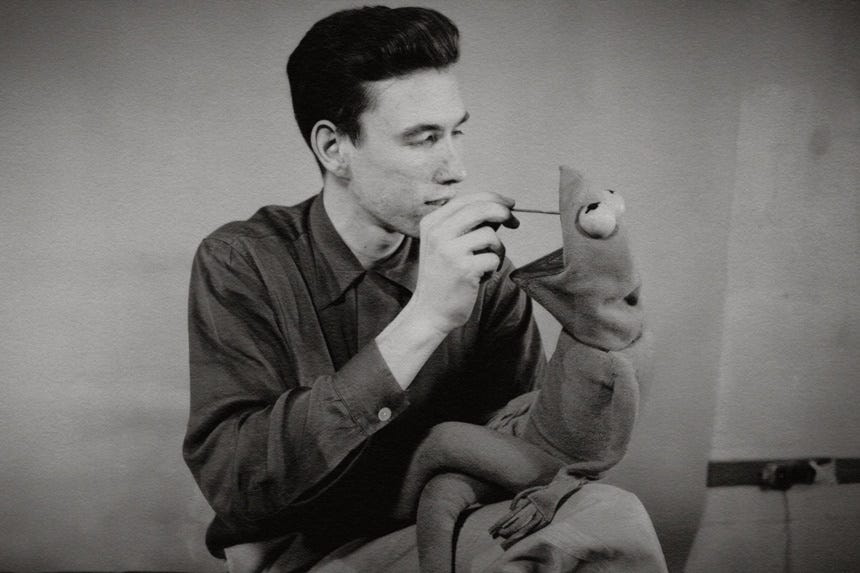Jim Henson Idea Man (2024)
The man who brought us The Muppets was on a lifelong creative journey
Henson worked for decades with his most durably whimsical creation, Kermit the Frog
Jim Henson Idea Man (2024)
Streaming on Disney+
Jim Henson’s name instantly brings to mind his most indelible, transformative creation, The Muppets. Since 1969, their raucous, cheerful, grouchy, hopeful, manic, wild-eyed, endlessly curious appearances on Sesame Street have enchanted not just their target audience, preschoolers, but older children and adults, too.
Sesame Street was created to make learning for very young children both engaging and fun. It broke “knowledge” into bites as easily absorbed as lemon drops.
But education wasn’t remotely on the minds of Henson (who never played with puppets as a child) and his wife Jane in the late 1950s and early ’60s when they dreamed up these furry, bigmouthed, mordantly staring creatures they called Muppets (a blend of marionettes and puppets).
The dream of Henson’s career had been to work in television, and the couple broke into the industry with an 11:30pm show from 1955 to 1961, Sam and Friends on WRC-TV in Washington, DC.
They gave their creations madcap, scary scripts, aimed specifically at adults. They didn’t shy away from edgy, real-life content. As Henson points out in this documentary, Muppet skits in their early development could be decidedly violent.
In vintage TV footage we see creatures, including an early incarnation of Kermit the Frog, exploding bombs in each other’s faces, punching one another and whacking one another over the head with clubs. This free-for-all mayhem was a late-night hit in contentious Washington.
Jim and Jane continued creating stage puppet shows, and in a trip to Europe Jim was inspired when he found the art of puppetry taken seriously, replete with competitions, theaters, financing, as well as elaborate costumes and staging.
Once he was back in the States, Henson and his even more loudly proud Muppets made guest appearances on variety shows hosted by the likes of Steve Allen, Jack Paar and Ed Sullivan, keeping Henson’s name before the public. His creations took on the cheerful anarchism of the short experimental movies Henson was also making.
Henson with Kermit (center left) and his gaggle of all-in Sesame Street Muppeteers
Joan Ganz Cooney deeply admired his talent. But as head of the Children’s Television Workshop, the producers of Sesame Street, she approached Henson with a strict set of guidelines.
She wanted all of his bustling creativity, but it had to be tempered for the tenderest audience, preschool children just beginning to awaken to the world around them. Violence was off the table.
Taking up Cooney’s offer wasn’t an about face for Henson and his team of Muppeteers. It proved to be a mind meld. Boisterousness and delightful happenstance could be transformed into teaching tools. Children could sing, clap and share jokes with puppets while grasping the alphabet, numbers and the points on a compass.
This beautifully crafted movie suggests that Henson was a protean creator and an unstoppably driven man. He earned lifelong devotion from hundreds of collaborators, while his creations – the very opposite of highbrow artistry – touched millions, young and old.
Socializing could be woven in. One of the team’s most popular creations was a combative puppet pair, uptight bow-tied Bert and zany scurrying Ernie. Henson and lifelong partner Frank Oz first alternated in the roles, eventually settling on Henson as wild man Ernie and Oz as fussy Bert.
Here were two combative temperaments learning to cooperate and get along. The payoff for kids in the studio and watching at home: they were acquiring people skills along with elementary sentence-building and math. Big Bird became the most masterful – and most popular – instance of gentleness stoked by curiosity.
In this eye-popping documentary, interspersed with sparkling graphics, Director Ron Howard and his crack editors Paul Crowder and Sierra Neal, along with multiple cinematographers, keep the eye engaged and the mind trying to figure out this gifted big kid creator.
Present at the creation: Kermit from green velvet, a ping pong ball cut in half for eyes
They’ve captured both the trajectory of Henson’s unique career and the warmth he felt and imparted to his many collaborators. Screenwriter Mark Monroe masterfully condenses a packed life that ended surprisingly early when Henson was only 53.
Sesame Street wasn’t the culmination of The Muppets or Henson’s creative drive. For TV in the U.S. and abroad, Henson, Oz and writer Jerry Juhl, among others, created The Muppet Show.
Rejected by the major American TV networks, it was picked up by impresario Lord Lew Grade in the UK, where it ran from 1976 to 1981; shortly after, it became an enormous hit in the U.S. when it was picked up for syndication.
The cast of Muppet characters expanded widely, attracting major stars eager to appear with these swarming madcap creations. Harry Belafonte, Elton John, Julie Andrews, Diana Ross, Roger Moore and Rita Moreno are among the grinning guests we see here in clips. The Muppet Movie (1979), The Great Muppet Caper (1981), and The Muppets Take Manhattan (1984) followed
In interviews, Henson’s five children provide a sense of how the family dynamic was both nurtured and wounded by worldwide success. Their loving father was all manic creativity, while their mother Jane remained the stalwart business partner as well as keeper of the home fires.
The two roles became insupportable. Jane eventually wanted more for herself than life as helpmeet to a “genius”, and the couple divorced with minimal rancor.
Henson’s drive only intensified. He created, co-directing with Oz, two now classic puppet-filled movies, The Dark Crystal (1982) and Labyrinth (1986). Critics mostly praised both, while each was only moderately successful at the box office, though Crystal became a big earner as a consistently best-selling video release.
All of this suggests, as this beautifully crafted movie documents, that Henson was both a protean creator and an unstoppably driven man. He earned lifelong devotion from hundreds of collaborators, while his creations – pointedly, the very opposite of highbrow artistry – touched millions, young and old.
And throughout the journey shown here, we see in Henson’s eyes delight mixed with restlessness, a paradoxical satisfaction mixed with an itching puzzlement, something at the edge of his eyes that seems to be bothering even goading him. He was churning out ideas, including a conception for a Broadway show, until the end.
He died unexpectedly, caught up in numerous projects, eyes, we see in clips, still twinkling as he worked with his collaborators.
It’s clear he didn’t just seek to bedazzle. He wanted to be bedazzled. The most moving moments in the picture come when, seeing his own creations spring to life, he breaks into a smile of helpless, astonished wonder.







Besides Animal, I never knew about the Muppets having an era of more violence. That’s pretty interesting, but I’m glad they were encouraged to tone it down. I can't imagine the glamorous Miss Piggy in that light.